Post-election commentary speaks of Corbyn’s party achieving “its worst result since 1935.” Alexander Mercouris shows why that is a serious misrepresentation.
Labour’s Defeat Is Being Overstated
By Alexander Mercourisin London
Special to Consortium News
Special to Consortium News
 The Conservative Party’s election victory is a personal tragedy for Jeremy Corbyn, whose quest to lead a transformative Labour government has ended in failure. It is also a tragedy for Britain, which has lost the opportunity offered by a transformative Corbyn-led Labour government.
The Conservative Party’s election victory is a personal tragedy for Jeremy Corbyn, whose quest to lead a transformative Labour government has ended in failure. It is also a tragedy for Britain, which has lost the opportunity offered by a transformative Corbyn-led Labour government.
It may also become a tragedy for the Labour Party, but only if it takes away the wrong lessons from its defeat.
The last point needs to be emphasized, all the more so since some of the reporting shows that there is quite clearly an agenda to overstate the extent of Labour’s defeat.
Most of the commentary speaks of Labour achieving “its worst result since 1935.” This is a serious misrepresentation of the facts.

Prime Minister Boris Johnson, left, and Labour leader Jeremy Corbyn during campaign debate. (Screenshot)
Labour’s vote share in the election was 32.2 percent. That compares with the 30.4 percent it achieved in the general election of 2015, just before Corbyn became leader, when the Labour Party was led by Ed Miliband.
It is also higher than the 29 percent vote share the Labour Party achieved in the general election of 2010, when it was led by the then incumbent Labour prime minister, Gordon Brown.
Going back further, Labour’s vote share in earlier general elections was 27.6 percent in 1983; and 30.8 percent in 1987.
Absolute Numbers of Votes
In terms of absolute numbers of votes, Labour in 2019 gained more votes than it did in the general election of 2005 (10,269,076 versus 9,552,436), which Labour won under the leadership of the then incumbent Labour prime minister, Tony Blair.
The claim that Labour achieved “its worst result since 1935” is based solely on the number of members of parliament (MPs) it returned to the House of Commons following the election that stands at 202.
This is indeed a historically low figure. However, saying that ignores the fact that Labour had already lost — in the general election of 2015 — 40 of its seats in Scotland, which it could formerly rely upon to reliably return a Labour MP. These 40 seats were lost to the left wing pro-independence Scottish Nationalist Party (SNP), not to the Conservatives. The SNP has held on to them ever since.
Labour has never been able to regain these lost 40 seats, and given the rise of pro-independence sentiment in Scotland it seems increasingly unlikely that it will ever do so.
Suffice to say that if Labour had retained these 40 seats in 2015, and had it held on to them in the latest general election, its cohort of MPs would now be 242 and not 202. That is significantly more than the 209 MPs it had after the election of 1983.
Ignorance, or in some cases willful disregard, of the extraordinary political transformation that took place in Scotland in 2015, and which has ever since affected Britain’s electoral and parliamentary arithmetic, seriously distorts discussion of British politics.
Like Labour, the SNP is a left-wing social democratic party. The political swing in Scotland — which took place in the election of 2015, not in the election that just took place — has not been from left to right or from Conservative to Labour. It has been from the unionist social democratic left (Labour) to the nationalist social democratic left (the SNP).
The SNP has just won 45 percent of the vote in Scotland, as compared to 25.6 percent for the Conservatives and 18.1 percent for Labour. The Conservatives have, moreover, just lost seven of their 13 seats. In Scotland there is a strong anti-Conservative sentiment, and in the event of a hung parliament the SNP made clear that it would have backed Labour.
On a related point, if the swing to the SNP had not taken place, and if the vote in Scotland had continued in line with previous pre-2015 elections, Labour’s total share of the vote in the current election would not have been 32.2 percent. It would have been roughly 34 percent.
That is close to the 35 percent Tony Blair achieved in the election of 2005, which Labour won, and is the same as the 34 percent Labour achieved in the election of 1992, when it was led by Neil Kinnock, which prepared the ground for the landslide of 1997.
In summary, Corbyn in 2019 won more votes and a bigger percentage of the vote than his two immediate predecessors, Gordon Brown and Ed Miliband. The Labour Party under his leadership also did significantly better than it did in the two elections held during the period of Margaret Thatcher’s ascendancy in the 1980s. Corbyn did slightly less well than did Kinnock in 1992, but only because of an earlier collapse in Scotland for which he is not responsible. Corbyn did only slightly less well in percentage term —but significantly better in numbers of actual votes cast — than did Tony Blair in 2005.
All this can be compared with the apocalyptic predictions which were made about his leadership before the election of 2017. Corbyn’s leadership was then said to be so incompetent and so disastrous that it would destroy the Labour Party as an electoral force.
Obviously and in reality, Corbyn has done much better than that. In fact, in terms of Labour’s recent electoral history, the vote share he won for Labour was creditable, and he has left the Labour Party with a bigger share of the vote and a much larger and more active membership than when he found it.
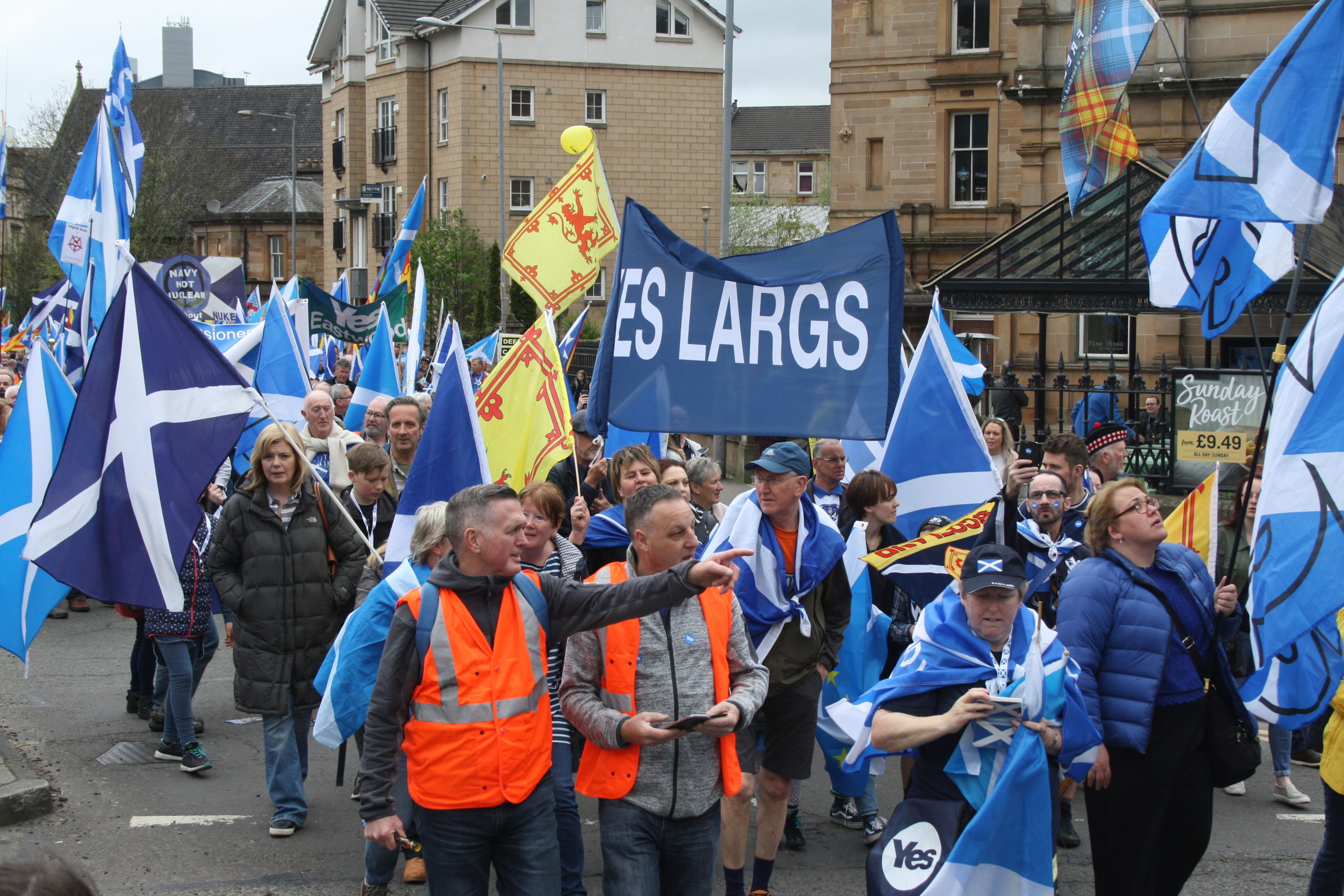
Scottish independence rally 2018. (Azerifactory, CC BY-SA 4.0, Wikimedia Commons)
Labour Didn’t Lose Because It’s ‘Too Left Wing’
All this should make one skeptical about claims that Labour lost the election because of Corbyn’s “excessive radicalism” or because Labour under his leadership became “too left wing.”
As it happens the radicalism of the manifesto on which Labour fought the election has been overstated.
Its three main standouts — the ending of student fees and the increase in welfare and National Health Service spending; the re-nationalization of the railways and of certain public utilities; and the plans for greater infrastructure spending and for an increase in public housing construction with a specific proposal to provide all British households with free broadband — would not have been considered radical in Labour’s social democratic heyday between 1945 and 1980.
Nor would the scale of the spending that Labour proposed have been excessive for a rich country like Britain, or have caused its bankruptcy. Again, the spending program that was announced would have been considered unexceptional during Labour’s social democratic heyday from 1945 to 1980.
Labour Party canvassers in fact found that the pledges in the manifesto were popular overall. The problem was not hostility to the manifesto as such, or concern about that it was “excessively radical” or “too left wing.” It was skepticism that a Labour government led by Jeremy Corbyn could make such a program work.
There is a further reason to doubt that Labour’s failure in the election was due to its being perceived as “too left wing.” This is the utter failure of the supposedly more “moderate” left-centrist alternative to the right of it.
None of the “moderate” Labour MPs who defected from the Labour Party in 2019 complaining about Labour’s “excessive radicalism” and anti-Semitism has won re-election to the House of Commons. Change UK, the party some of them set up, has failed to win a single seat, and looks certain to be wound up.
As for those “moderate” Labour MPs who chose to join the Liberal Democrats, they too have failed to win any seats.
Luciana Berger — a former member of the shadow cabinet of the previous Labour leader Ed Miliband — who left the Labour Party specifically highlighting its alleged problem of anti-Semitism, and who was much fancied to win election in Finchley and Golders Green, a parliamentary constituency with a large Jewish population — in the end failed to do so. The seat was retained by the Conservatives.
As for the Liberal Democrats — the traditional party of Britain’s “moderate” center left — expectations before the election that they would win as many as 100 seats and would overtake the Labour Party in share of the vote have been crushingly disappointed.
The Liberal Democrats’ share of the vote share did increase, but only slightly, from a derisory 7.4 percent in 2017 to just 11.6 percent. Compare that with the share of the vote of Jeremy Corbyn’s supposedly “extremist” Labour Party, which is three times greater at 32.2 percent.

Jo Swinson in 2017. (Keith Edkins, CC BY-SA 3.0, Wikimedia Commons)
In addition the Liberal Democrats suffered the humiliation of seeing their number of MPs actually fall by comparison with 2017 from 12 to 11, whilst their leader, Jo Swinson, actually lost her seat in Scotland to Labour’s putative ally, the left wing social democratic SNP.
Compare these dismal results with what the Liberal Democrats achieved as recently as the 2005 general election, when the “Labour moderate” Tony Blair was in power as prime minister. In that election the Liberal Democrats’ share of the vote was 22 percent, and their number of MPs was 62.
The Liberal Democrats’ strategy during the election was in fact to position the party as the “sensible” “middle of the road” alternative both to the Conservatives and to Jeremy Corbyn’s supposedly “extremist” Labour Party. Accordingly, the Liberal Democrats fought the election promising to cancel Brexit whilst saying they would never agree to enter into a coalition with the “left wing extremist” Jeremy Corbyn.
In the event most “moderate” anti-Brexit Conservative voters chose to stick with their party, whilst the trend amongst supposedly “moderate” left of center voters was for them to switch during the election from the supposedly more “moderate” Liberal Democrats to the supposedly more “extreme” Labour Party.
Compare this with what happened in the general election of 1983, when the British electorate really did think that the Labour Party had become too left wing and too extreme.
Over the course of that election the share of the vote of what was then the Liberal-Social Democratic Alliance (the ancestor of today’s Liberal Democrats) increased steadily, so that at the end of the election they won 25.4 percent of the vote compared with the 13.8 percent the Liberals had won in the previous election of 1979. Overwhelmingly this was at the expense of Labour, whose share of the vote crashed from 36.9 percent in 1979 to 27.6 percent in 1983.
Labour did not lose the election because the electorate saw it as too left wing. The facts show otherwise. Like the claim that Labour achieved its “worst result since 1935” this claim is a piece of misrepresentation peddled by those who want Labour to return to the status quo policies and triangulation of the Blair era.
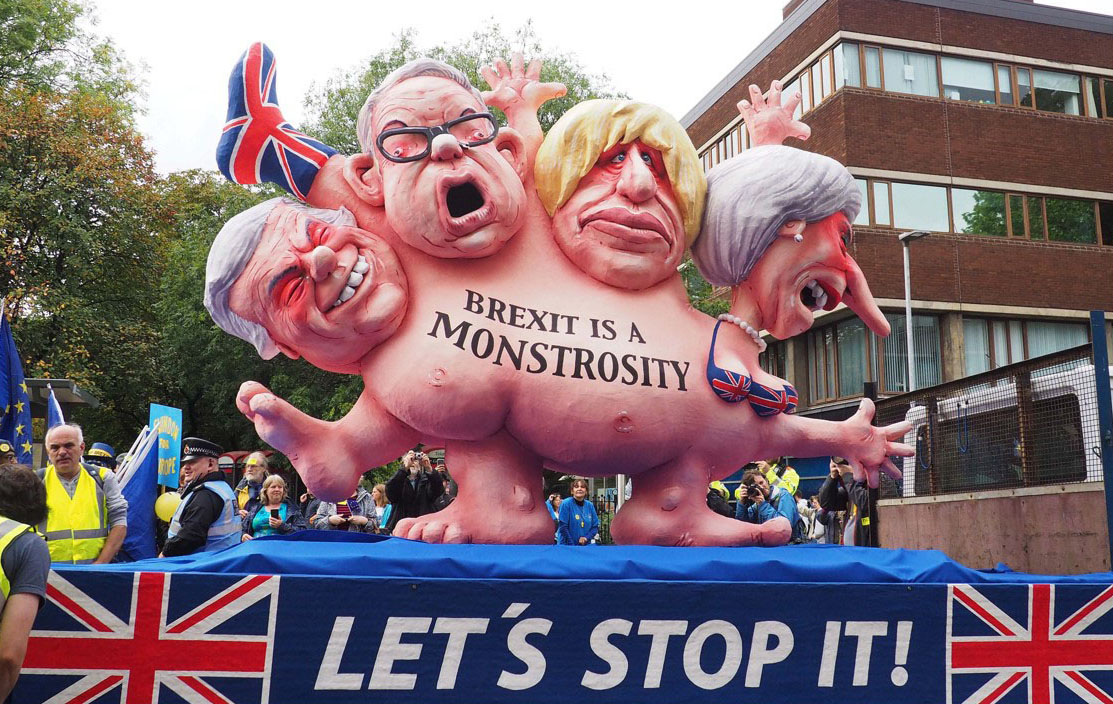
Anti-Brexit demonstration in Manchester, England, Oct. 1, 2017. (Robert Mandel via Wikimedia)
Why Then Did Labour Lose?
The short and unavoidable answer — and one which is gradually gaining acceptance, despite continued denials from some quarters — is because of Labour’s stance on Brexit.
A survey of Labour losses makes this fact overwhelmingly clear. Though there was a swing from Labour to Conservative across the whole of England and Wales (Scotland, as discussed above, now has a wholly different politics) the swing was not uniform, and was biggest, and Labour’s losses were far and away greatest, in northern England and in the English Midlands.
It is not a coincidence that these regions voted heavily for Brexit in the 2016 referendum.
By contrast in those areas which voted against Brexit in the 2016 referendum the Labour vote held up better, and Labour losses were relatively few.
By way of example, in London, which in the 2016 referendum voted overwhelmingly against Brexit (by a margin of 60 to 40) Labour narrowly lost Kensington & Chelsea (by just 150 votes) but won Putney from the Conservatives. In total Labour holds as many seats in London after the election as it did before.
The same pattern repeated itself in other areas that voted against Brexit in the 2016 referendum.
In Canterbury, which also voted in the 2016 referendum against Brexit, and Labour won from the Conservatives for the first time in the election of 2017, Labour won again with a bigger majority and an increase in its share of the vote.
The same is true in other anti-Brexit urban areas such as Manchester, Bristol and Cardiff. Labour won in all three, achieving a clean sweep of all the seats fought there.
Overall, as surveys of the voting across England and Wales make clear, Labour held on to the great majority of its voters who voted against Brexit in the 2016 referendum, but lost roughly half of its voters who in the 2016 referendum voted for Brexit. It was this which caused Labour’s defeat and the Conservatives’ victory.
In raw terms of parliamentary arithmetic, this meant that the Labour Party lost a swathe of seats across its former heartland in northern England and in the English Midlands, which had voted for Brexit in the referendum of 2016, giving the Conservatives the clear election victory and the large parliamentary majority they now have.
This points to the underlying explanation for Labour’s debacle, which was Labour’s impossibly over-complicated Brexit policy.
Where Boris Johnson and the Conservatives had a simple and clear message — “Get Brexit Done” — the Labour Party fought the election on a policy of negotiating an entirely new Brexit deal different from Boris Johnson’s, which it said it would then put to a vote in a second referendum, with the option of remaining in the European Union offered as the alternative.
This proposal, committing Labour to a second referendum on an issue which most British voters had been told had been decided by the 2016 referendum, was bound to be unpopular with voters who in the 2016 referendum had voted for Brexit. What however made this proposal utterly toxic was the stance towards the proposed referendum which was taken by almost the entirety of Labour leadership.
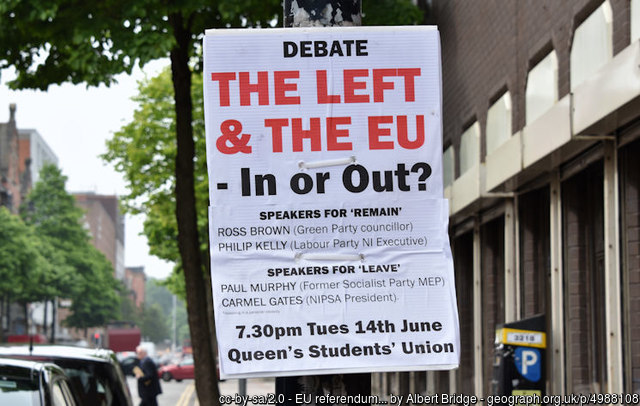 John McDonnell, Labour’s shadow chancellor and its effective No. 2; Emily Thornberry, Labour’s shadow foreign secretary; Diane Abbott, Labour’s shadow home secretary; and Keir Starmer, Labour’s Brexit spokesman, all said they would vote in this second referendum in favor of remaining in the European Union — in other words against the deal Labour was saying it was going to negotiate with the European Union.
John McDonnell, Labour’s shadow chancellor and its effective No. 2; Emily Thornberry, Labour’s shadow foreign secretary; Diane Abbott, Labour’s shadow home secretary; and Keir Starmer, Labour’s Brexit spokesman, all said they would vote in this second referendum in favor of remaining in the European Union — in other words against the deal Labour was saying it was going to negotiate with the European Union.
As for Corbyn himself, he said he would remain “neutral” — in other words he too was saying that he would not support in the referendum the deal Labour was saying it would negotiate with the European Union.
Needless to say, this would have meant that with Labour failing to support its own proposed deal, the deal would have been all but certain to be rejected, and the option of remaining in the European Union would have won.
This exposed the whole second referendum proposal as what it obviously was: a complicated mechanism to cancel the result of the 2016 referendum by staging what would have been an obviously rigged referendum on a deal that was clearly intended to fail.
Unsurprisingly, pro-Brexit working-class voters in northern England and in the English Midlands, presented with a proposal like this, turned their backs on Labour, and voted for the Conservatives instead.
It was this ultimately dishonest Brexit policy — one which sought to cancel the result of the 2016 referendum without actually saying so — which in my opinion explains the strong antipathy towards Jeremy Corbyn that Labour canvassers discovered as they campaigned in their former northern England and English Midlands heartlands.
During the 2017 general election the British electorate warmed to Jeremy Corbyn, who was seen as a straightforward and principled if rather eccentric man, sincerely interested in making the lives of the British people better.
By contrast, during the 2019 general election, with Jeremy Corbyn proposing a Brexit policy which was ultimately both dishonest and absurd, he came over as just another politician.
The bitter anger and sense of betrayal in the circumstances is entirely unsurprising, and was made worse amongst older voters — a disproportionate number of whom had voted for Brexit — because they would have remembered that Corbyn had opposed Britain’s European Union membership for most of his political life.
Overstating Effect of Anti-Corbyn Smears
This anger and sense of betrayal also explains why the smears about Corbyn as an anti-Semite, a traitor, a friend of terrorists, and the rest, endlessly recycled by the Conservative Party and their right wing media friends, this time stuck, which they had failed to do in 2017.
There is an understandable temptation to see these smears as the reason for Labour’s election defeat.
This temptation should be resisted. Every Labour leader since the establishment of the Labour Party except for Tony Blair has been the target of right-wing smears. The smear campaign against Corbyn may have been more intense than others. However, working-class voters in northern England and the English Midlands — traditionally the Labour Party’s core vote — have historically proven to be the least susceptible voters to such smears.
That on this occasion they turned against Corbyn and the Labour Party to the point where some of them began repeating these smears shows how great their anger and sense of betrayal was.
Inevitably, given such feelings, the response of these voters to Labour’s proposals in its manifesto, instead of being supportive as had been the case in 2017, was cynical. Since these voters no longer believed Corbyn or the Labour Party on Brexit, they no longer believed them on anything else.
All of this was not only predictable; it was widely predicted. Commentators ranging from Neil Clarkon the left to Dominic Lawson on the right repeatedly pointed out, both before and during the election, that the Labour Party’s Brexit proposal was electorally suicidal, and was certain to result for the party in a heavy defeat.
Jeremy Corbyn himself is known to have long opposed the proposal for precisely this reason, as did his key advisers, Andrew Murray and Seamus Milne. The Labour Party’s chairman Ian Lavery, who is himself a northern England MP, also strongly and publicly opposed it. So did several other Labour MPs representing seats in northern England and in the English Midlands.
Why then was this bizarre and seemingly suicidal policy adopted?
There has been much discussion about this, with some attributing this to weakness on the part of Corbyn, who supposedly let himself be bullied into agreeing to a policy he knew was wrong by the strongly anti-Brexit and Blairite elements within the Labour leadership and amongst Labour’s MPs.
There is some force to this claim. Certain prominent figures in the Labour Party, notably the shadow chancellor, John McDonnell; the shadow Brexit minister, Keir Starmer; the shadow foreign minister, Emily Thornberry; and the shadow home secretary, Diane Abbott; did indeed apply extraordinary pressure upon Corbyn to get him to adopt the policy.
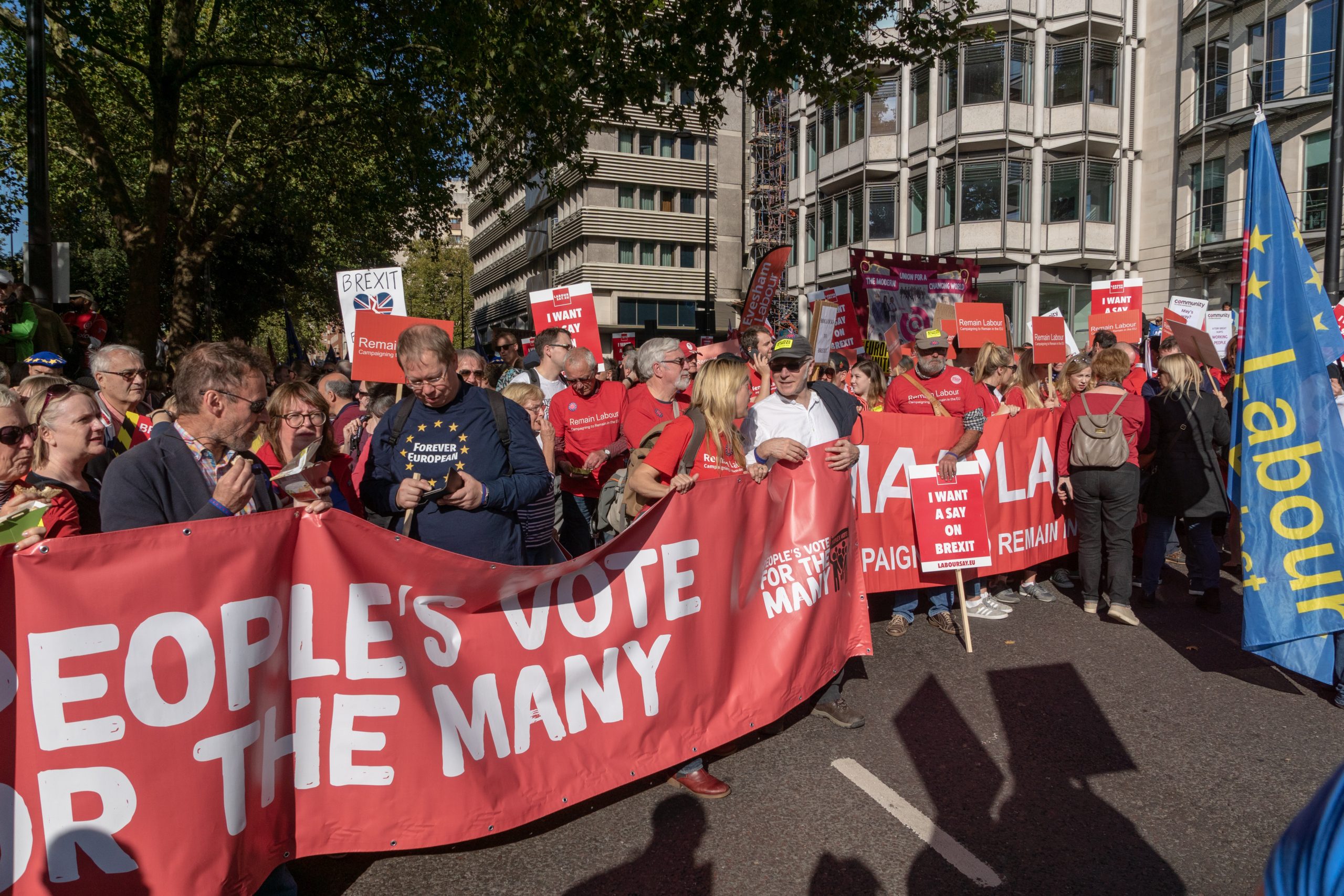
People’s Vote march, October, 2018. (Colin, CC BY-SA 4.0, Wikimedia Commons)
Keir Starmer, who is a committed opponent of Brexit and a strong supporter of keeping Britain in the European Union, appears to have been not just a proponent of the policy but also its principal author, which he borrowed from the anti-Brexit and pro-European Union People’s Vote campaign.
Starmer is a brilliant lawyer, and both the policy and the tactics he followed as the Labour Party’s Brexit minister were in fact very much such as one might expect from such a lawyer, who saw Brexit as essentially a problem to be litigated away by wire-pulling and clever parliamentary tactics, rather than as the major political headache for the Labour Party, which it in fact was.
One result of this approach was that it led the Labour Party into becoming involved in a series of complex parliamentary manoeuvres hatched by various dissident anti-Brexit Conservative MPs, whose primary purpose seem to have been to embarrass the two successive Conservative prime ministers, Theresa May and Boris Johnson.
These intrigues did cause some temporary embarrassment to the Conservative government. However, the Labour Party’s involvement in them in the end only solidified the impression in the country that the Labour Party was opposing Brexit. Taken together with the Labour Party’s referendum policy, the impression this gave in the Brexit-supporting regions of northern England and the English Midlands ultimately proved disastrous.
Shift in Labour’s Character & Base
It is important however to recognize that there were also compelling reasons why the Labour Party in the end adopted its second referendum policy. These relate to the shift in the character of the Labour Party and of its electoral base which has been underway for the last three decades.
Though working-class voters in northern England, the English Midlands and elsewhere, were once the Labour Party’s core supporters, that is no longer the case.
Whereas in the election of 1979 around 80 percent of voters who voted Labour were manual workers, today that proportion has fallen to around 40 percent.
Right up to the 1980s the Labour Party spoke of itself as “the political wing” of a “Labour movement” of which the trade unions were “the industrial wing.” It is decades since I have heard any Labour politician speak of the Labour Party in that way. Nor is that surprising since such language no longer describes the Labour Party in any true sense.
Particularly during the New Labour era of Tony Blair the Labour Party has sought to respond to the decline of its working-class electoral base caused by de-industrialization and Margaret Thatcher’s assault on trade unions by refocusing the Labour Party increasingly on winning over the progressively minded middle class voters in London and in Britain’s major cities.
That has meant that whilst for historic reasons the old working heartlands of the north of England and in the English Midlands continue to account for a very large proportion of Labour seats returning Labour MPs to the House of Commons, an increasingly large proportion of the Labour Party’s members and of its MPs are now middle class as are many of the voters who supported the Labour Party in elections.
The rise of Jeremy Corbyn has intensified this trend. One of the features of the period of Corbyn’s ascendancy within the Labour Party is that there has been a huge increase in the party’s membership, with the great majority of the new members being from the progressive middle class.
A further striking feature of the Corbyn era has been the increasingly sharp division of the British electorate on age lines.
Whereas in the election of 1983 42 percent of young people aged 18-24 voted Conservative as opposed to just 33 percent who voted Labour, in the general election that just took place 57 percent of people aged 18-24 voted Labour, as opposed to just 19 percent who voted Conservative.
By contrast pension-age voters, many of whom would have voted Labour in their youth and who would once have held working-class jobs in Britain’s now closed coal mines and factories, now vote overwhelmingly Conservative. In the general election that just took place 62 percent of pensioners voted Conservative, as opposed to just 18 percent who voted Labour. This almost exactly correlates to the 60 percent of pensioners who voted for Brexit in the 2016 referendum.
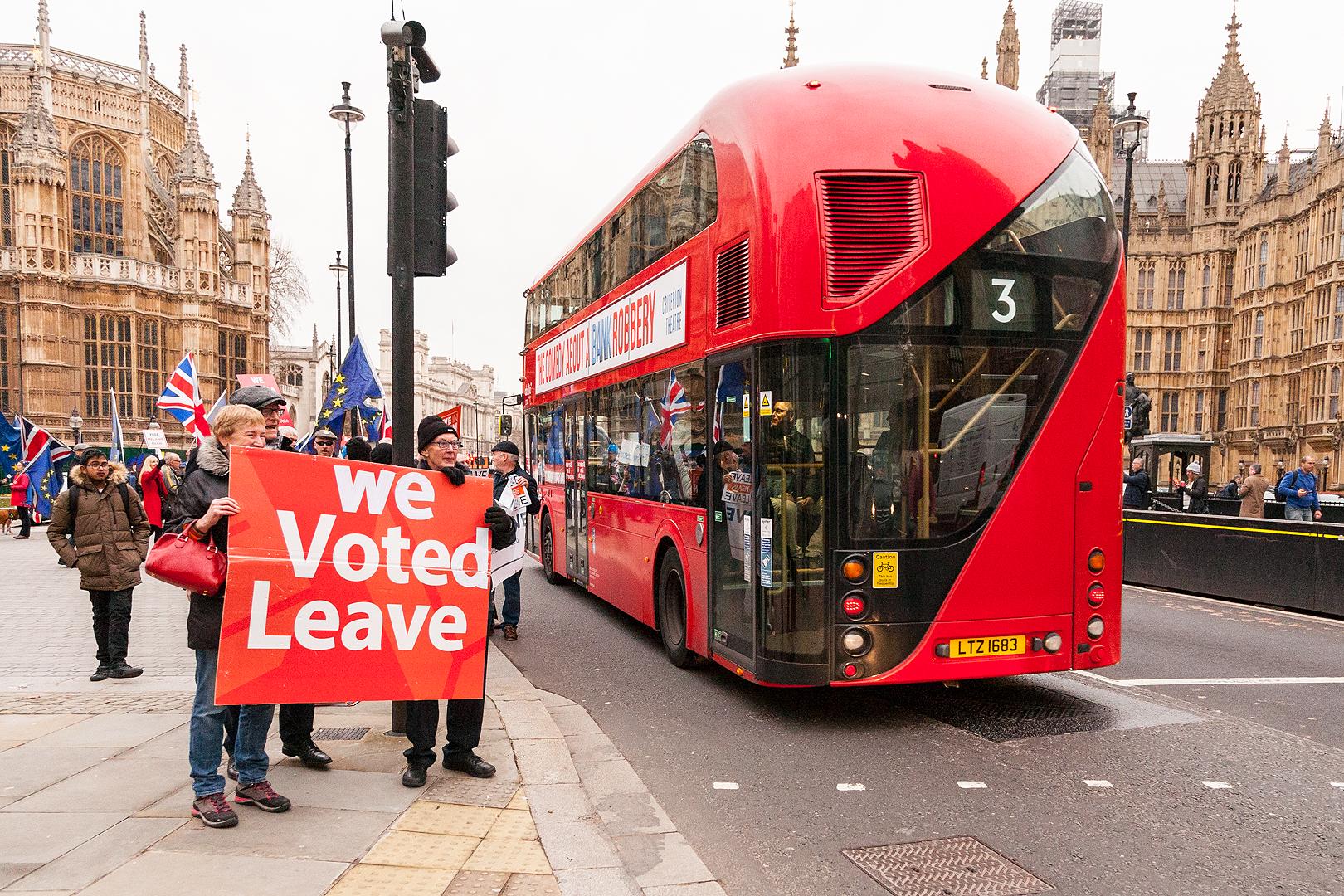
Brexit supporters, December 2018. (Mark Ramsay/Flickr)
In summary, support for the Labour Party now comes overwhelmingly from younger people, either students or workers in paid employment, very few of whom work doing the sort of jobs in the mines and the factories that once defined the sort of people who voted Labour.
Moreover, these new Labour voters tend increasingly to live, study and work not in Britain’s former small industrial and mining towns in the north of England in the English Midlands, but rather in Britain’s big cities and population centers.
It is the cities that also increasingly provide Labour’s political leadership, with London playing a disproportionate role.
Corbyn is himself a London MP. So are nearly all the other key members of Labour’s current leadership group. John McDonnell, Keir Starmer, Emily Thornberry and Diane Abbott are also London MPs.
It becomes much easier to understand the nature of Labour’s Brexit problem once the fact is grasped that the vast majority of those who now form Labour’s younger, more middle-class electoral base in the 2016 referendum voted for Britain to remain in the European Union.
This is most extreme amongst the youngest voters, who are also the voters most likely to vote Labour. Amongst young voters aged 18-24 who voted in the 2016 Brexit referendum, 73 percent voted for Britain to remain in the European Union.
Brexit Split
This explains the critical divide within the Labour supporting electorate on the Brexit issue, which in the end was to prove so disastrous for Labour in the election.
It is a divide that also has a distinct cultural character.
Support for Brexit in England and Wales is often said to be essentially an English nationalist anti-immigrant position.
Whilst there is some truth to this, it is important to say that English working-class voters — the voters who used to form Labour’s core electorate, and who deserted Labour in large numbers in the election — have never at any time been keen on the European Union. These voters were overwhelmingly the demographic that voted against Britain joining the European Economic Community (the lineal ancestor of today’s European Union) in the 1975 referendum, when importantly immigration from the EU was not an issue. It was also this same demographic — at that time still very much Labour’s core electorate — that pushed Labour into adopting an outright anti-Europe pro-Brexit position in the general election of 1983.
These voters have traditionally seen the European Union as a hostile entity, aligned with elites and employers, and inimical to their interests.
Anti-immigrant sentiment undoubtedly plays a part in this, with the commonly expressed view that EU membership enables British employers to ship in cheap workers from eastern and southern Europe, undercutting British wages and losing British workers their jobs. Whilst it seems that there may be some truth to this claim, strikingly these sentiments today are often expressed by working-class people who are now retired, and who therefore no longer receive wages or have paid jobs.
By contrast Labour’s new younger urban middle-class electorate — which is now a majority of voters who vote Labour — has an overwhelmingly positive view of the European Union.
For these voters, withdrawal from the European Union is the shutting of Britain’s doors to the wider world and a retreat into insular exclusiveness.
This is unacceptable, especially in London, which today increasingly conceives of itself as a world city and not just as a British city.
Not only are these views and sentiments diametrically opposed to each other but they also come with a considerable dose on each side of class prejudice.
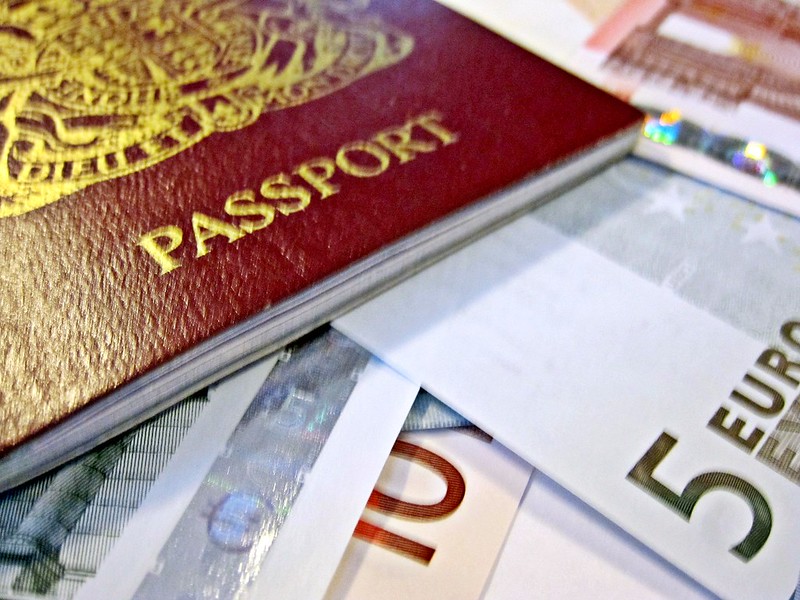
Passport and Euros. (Images Money/Flickr)
Working-class voters resent what they see — with some justice — as the condescension of affluent middle class voters in London and the big cities. They tend to be scornful of claims that Brexit will result in economic catastrophe, seeing in such claims the self-serving scaremongering of a middle class worried about losing its European holidays and its Erasmus scholarships.
Urban middle-class voters by contrast all too often tend to see working-class hostility to the European Union as the product of ignorance tinged by racism and xenophobia, which is being cynically exploited by right wing demagogues such as Boris Johnson and Nigel Farage.
Straddling a Divide
Given the passionate feelings on each side of Labour’s Brexit divide, it was inevitable that Labour would struggle to hold together the two sides of its increasingly unwieldy and fractious electoral coalition in an election where Brexit is the overriding issue.
Given that this was so a strong case can be made that since the Labour Party in the end had no choice but to back one side of its own Brexit divide, it made the right choice — in terms of its own long-term interests — by in the end agreeing to the demand for a second referendum.
Not only is Labour’s new middle-class base now much bigger than its old working-class base, it is also the part of Labour’s fastest-growing base, and which is more articulate and more dynamic. To say it straightforwardly, it is the part of Labour’s electoral coalition which it most needs in the future.
If Labour had taken a more obviously pro-Brexit position, it would have risked alienating this new electorate, whilst its membership and its activists would have become demoralized and cynical. Support in Labour’s key urban strongholds would have slipped away, not to the Conservatives but to the Liberal Democrats.
That was in fact precisely what was starting to happen in the first half of this year.
At the same time that the Conservative Party on the right was losing support to Nigel Farage’s Brexit Party, the Labour Party on the left was simultaneously losing support to the strongly anti-Brexit Liberal Democrats, precisely because at that time it was resisting committing itself to a second referendum.
In the May 2019 European elections the Labour Party was overtaken by the Liberal Democrats in percentage of the vote won, just as the Conservatives were in those same elections overtaken by the Brexit Party. The Liberal Democrats were even starting to win over anti-Brexit Labour voters inJeremy Corbyn’s own north London constituency in Islington.
A victorious Liberal Democrat Party, overtaking Labour in vote share and winning seats from Labour in England and Wales’s urban centers in a British general election, would be a far greater existential threat to the Labour Party than the Conservative Party winning Labour seats in Labour’s former heartlands in the north of England and in the English Midlands.
Labour can survive the loss to the Conservatives of a place like Blyth Valley, which it can realistically hope one day to win back. If, however, the party were to lose a swathe of seats in places like north London and Manchester to a rival center-left party such as the Liberal Democrats, there would be no certainty that it would ever win them back. Labour’s very existence as Britain’s main center-left opposition party would be in doubt.
What that means is that once the People’s Vote Campaign, with its demand for a second referendum, began to gain traction amongst voters in Labour’s urban middle-class electoral base, it was only a matter of time before the Labour Party fell into line and adopted the policy of holding a second referendum.
That in turn led directly to the debacle in the election which followed.
Corbyn’s Failure
Saying all this does not acquit Jeremy Corbyn and the Labour leadership of responsibility for what has happened.
The fundamental problem with Corbyn’s and Labour’s approach to the whole Brexit issue is that they failed to realize until it was far too late the size of the problem it represented.
Corbyn himself is said to have been bored by the whole Brexit issue. I have heard stories that whenever the subject of Brexit came up his eyes would glaze over, only for them to brighten up again when the discussion moved back to those issues which really interest him, such as housing or social provision.
Up to the end of 2018 this approach worked reasonably well. Theresa May’s government struggled to come up with a coherent Brexit policy, and went into the 2017 general election without one, so that the Labour Party came under no pressure to explain its own.
This was what made it possible for Corbyn and the Labour Party to move the whole subject of the discussion during the 2017 election away from Brexit and onto Corbyn’s and Labour’s popular policies for transformative change. All Corbyn and Labour had to do was say that they would “respect the result of the 2016 referendum” and that was enough. That simultaneously reassured pro-Brexit voters in Labour’s working-class north England and English Midlands heartlands that their choice in the 2016 was being respected, whilst at the same time causing no alarm on the part of Labour’s anti Brexit middle-class voters in Britain’s urban centers, who were not being presented with an actual Brexit policy that they needed to worry about.
As a result, Labour achieved in the 2017 election one of the biggest surges in support for an opposition party in British electoral history, with the Labour Party increasing its share of the vote from 30 percent to 40 percent.
However once Theresa May did come up with a Brexit proposal, Corbyn’s and Labour’s failure to develop a coherent Brexit strategy was quickly exposed.
Inevitably the People’s Vote campaign, enthusiastically backed by prominent anti-Brexit Labour Party figures such as Emily Thornberry and Keir Starmer, filled the gap.
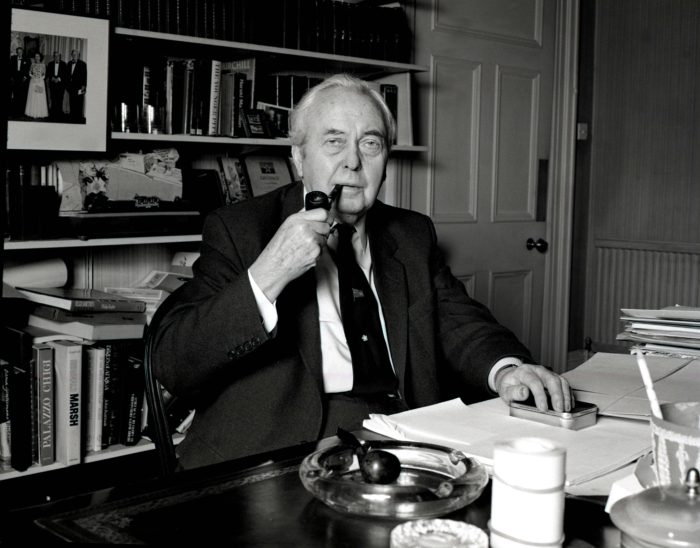
Harold Wilson in 1986. (Allan Warren, CC BY-SA 3.0, via Wikimedia Commons)
A more supple Labour leader, one more sensitive to the divergent opinions in the Labour Party and with a better grasp of the danger Brexit represented to the Labour Party’s electoral prospects, would have handled things differently.
Such a leader would have realized that the Labour Party’s interests lay in getting Brexit “done” as soon as possible, so that the whole subject was got out of the way long before an election was fought and whilst the Conservatives were still in power.
Inevitably, given the difficult parliamentary arithmetic, that would have meant taking steps to help Theresa May get her deal through the House of Commons.
That sort of approach would have gifted the Labour Party with a whole set of powerful advantages.
The Conservatives would have been left saddled with an unpopular and discredited leader in the person of Theresa May. They would also have been stuck with a Brexit deal which most Conservatives in the country loathed and rejected, and which was strongly opposed by the Brexit Party and its leader Nigel Farage.
The result would have been a divided and demoralized Conservative Party, racked by feuds, and threatened by Nigel Farage’s newly minted Brexit Party in its own strongholds.
The ground would have been laid for a Labour landslide on the same scale as those of 1945 and 1997.
There is some evidence that Jeremy Corbyn gave serious thought to this approach. At the Labour Party’s conference in the autumn of 2018 he appeared to reach out to Theresa May in a way that suggested that he was willing to help her get a Brexit deal through the House of Commons.
If Corbyn did however give any thought to adopting this approach, the record shows that he quickly gave up on it.
Perhaps he was talked out of it by Starmer or Thornberry. More likely he was intimidated by fear of the inevitably angry reaction there would have been from some anti-Brexit Labour MPs and from his own party activists, as well as from The Guardian newspaper.
If such fears explain Corbyn’s actions, then it needs to be said that these fears were groundless.
Corbyn would not have needed to instruct Labour MPs to vote for Theresa May’s deal in any vote in the House of Commons. An instruction to abstain would have sufficed. That would have automatically limited any opportunity for any anti-Corbyn grandstanding by any disaffected anti-Brexit and anti-Corbyn Labour MPs.
As for anti-Brexit opinion in the wider Labour Party, Corbyn could have assuaged it by pointing out that a Brexit deal on Theresa May’s terms, which would have kept Britain in fact if not in name in the European Union’s Customs Union and Single Market, would be easily reversible by a future government, and that the Labour Party was keeping that option open. What would have given that sort of assurance extra force is that it would have summarized Theresa May’s deal entirely correctly.
Doubtless there would still have been an angry reaction from some people, but with Brexit out of the way the Labour Party would have quickly reunited behind Corbyn, just as the Conservative Party would have started to fall apart.
Corbyn’s failure to grasp this opportunity stands in sharp contrast with the skill that an earlier Labour leader, Harold Wilson, showed in his handling of a similar crisis back in the 1970s.
It was the inevitable consequence of the Labour membership’s decision to elect a leader — Jeremy Corbyn — who for all his many virtues and fine qualities was temperamentally unsuited to the role, so that he always in the end preferred to avoid confrontations and to put off difficult decisions, even when his own interests and those of the Labour Party demanded a firmer approach.
The result was drift, which in the end resulted in Corbyn and the Labour leadership being confronted by a binary choice of either agreeing to a second referendum or refusing to do so.
Though they chose what was, from the Labour Party’s point of view, the least-bad policy of agreeing to a second referendum, doing so inevitably paved the way for their and Labour’s defeat.
The Future
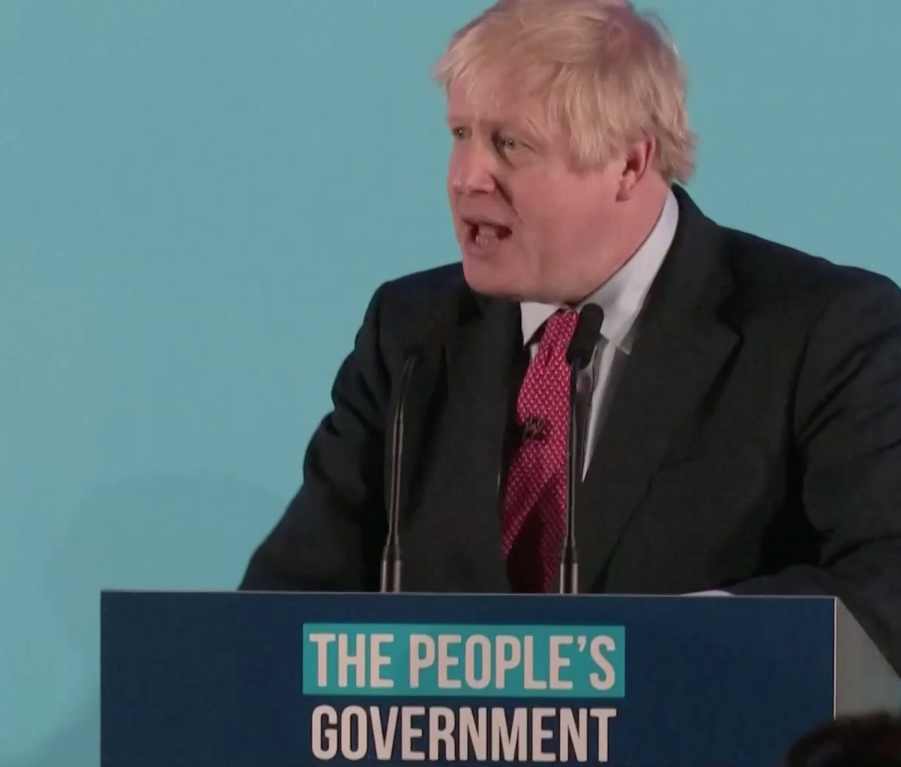
Boris Johnson delivering victory speech, Dec. 13, 2019. (YouTube screenshot)
The election defeat has however had the one positive effect for the Labour Party, which is that it has finally got the Brexit issue out of the way.
Boris Johnson now has no excuse not to “get Brexit done,” and presumably it soon will be “done.” The pro-Brexit working-class voters who flocked to Johnson in the north of England and in the English Midlands in order to “get Brexit done,” and who have just provided him with his majority, will then have no further reason to stick with him. There must be at least a reasonable chance that with attractive policies and a different leader uncontaminated by the Brexit issue the Labour Party can win them back.
In order for that to happen the new Labour leader must however build on that part of the Corbyn legacy that most voters — not just working-class voters — have found attractive. That points to sticking with most of the policies set out in Labour’s manifesto. As shown both in this election and in the previous election of 2017, these policies overall are popular, and in an election no longer clouded by Brexit they stand a good chance of winning support.
Certainly, they offer a far better prospect of reuniting Labour’s now -fractured electoral base than would a retreat back into sterile Blairite triangulation.
That points to the next Labour leader being someone who is genuinely committed to Corbyn’s program, but who is also able to communicate to working-class voters in the north of England and in the English Midlands in a way that Corbyn ultimately failed to do.
Rebecca Long Bailey, a capable lawyer loyal to Corbyn, of northern working-class origins, and representing a seat (Salford) which in the 2016 referendum voted for Brexit, but which she was able to retain in the election with only a relatively small drop in support, is an obvious possibility.
Labour, despite some of the headlines, remains a powerful electoral force. It commands the support of a third of the British electorate, even following an election held in the most unfavorable circumstances. With the Brexit issue finally out of the way the peculiar set of circumstances that made the 2019 election so difficult for Labour are unlikely to recur.
The way forward for Labour is for the party to hold its nerve and avoid descending into recriminations and factional infighting. Objectively, there is no reason why it cannot win again.
Alexander Mercouris is a political commentator and editor of The Duran.


1 opmerking:
The author is to be commended for identifying Labour as a '..social democratic party.'
Philip Snowden, Labour MP:
“The British Labour Party is certainly not Socialist in the sense in which Socialism is understood upon the Continent. It is not based upon the recognition of the class struggle; it does not accept the teaching of Marx . . .” (Manchester Guardian Reconstruction Supplement. 26th Oct., 1922.)
Labour advocate reforms of capitalism, not socialism.
No Labour government has ever left office with unemployment lower than when it started.
Labour has supported all wars since WWI.
Aneurin Bevan promised to solve the housing problem....
With regard to the NHS. Labour Minister Bevan had his own private physician, and saw charges imposed for dental and optical services.
Labour supported while in government the passing of the racist Commonwealth Immigrants Act 1968
Recall the use of troops as strike breakers against the dockworkers.
Tuition fees? That was Labour too.
1999: Blair: ‘Our historic aim will be for ours to be the first generation to end child poverty forever, and it will take a generation. It is a twenty-year mission, but I believe it can be done.’
2019: ‘DWP child poverty figures a ‘national scandal’ as 4.1million kids are hit’ (mirror.co.uk, 28 March).
Further spins on the reformist misery-go-round await should Labour ever be re-elected.
Een reactie posten